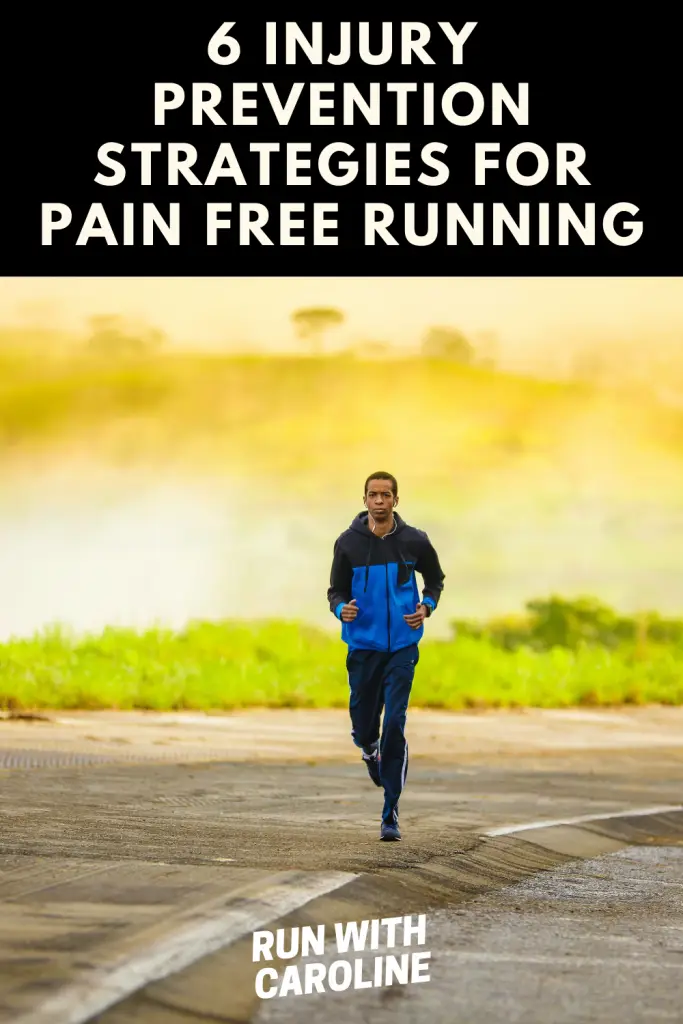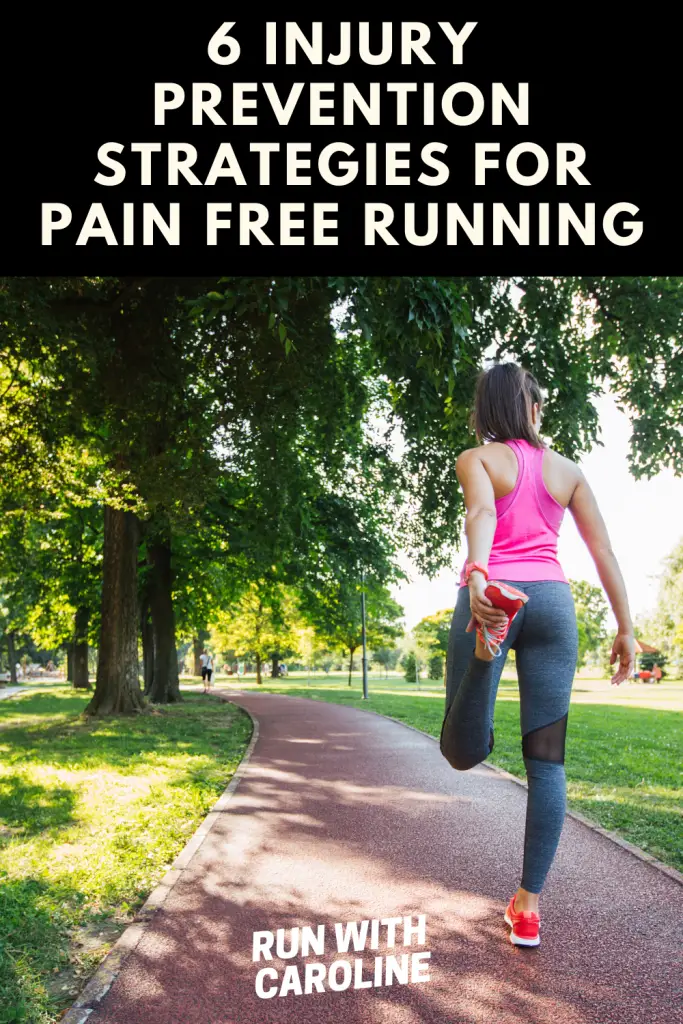There’s nothing more annoying and disheartening for a runner than pain.
Pain can stop you in your tracks or it can be chronic – starting small and gradually getting worse over time.
The last thing a runner wants or needs is an injury. But with these injury prevention strategies you can learn how to stop injuries in the first place and have more pain free running.
There are many common, running-related injuries out there that runners of all levels encounter at one time or another in their running journey.
Most running injuries like IT band syndrome, shin splints and plantar fascitis are the result of overuse. Other factors like improper fitting running shoes can also make running injuries worse.
By paying attention to your body and adding a few simple things into your training routine, you can avoid a lot of these overuse injuries.
A good injury prevention strategy is essential for any runner looking to feel good and run strong week in, week out.
So, if you’re building up to your next race, then these six injury prevention strategies for pain free running have got you covered!

Listen to your body
Your brain is responsible for sending signals to your body to let it know when to run, when to stop, when to rest, when to recover.
Listen to your body and really try and focus on what it is telling you. If you have a gut feeling that today is not the day for that long run, then listen to your gut.
Usually, signs of an overuse injury start as a whisper. Don’t ignore it before it’s too late.
Tune into your body and muscles and ask yourself: “How do your legs feel?” “How do your feet feel?” “How strong do you feel?”
If you start to feel a niggling pain, take a step back and assess where it could be coming from and what you could do to minimise this pain before it gets worse.
Listening to your body also means spending adequate time for rest and recovery. Rest and recovery are essential for any runner looking to stay injury free.
Many runners consider rest days lost time. Don’t worry – you won’t lose all your running fitness in one day!
Instead, view your rest day differently. Take some time to do something other than running.
Cross training (or ‘active recovery’) activities like yoga and walking are all good examples.
Remember, you need your rest days as much as you need your long runs and speedwork.
Build up your mileage slowly
Avoid sudden increases in intensity, frequency and duration in your training plan. Many overuse injuries, like shin splints, are caused by doing too much too soon.
Follow a training plan and stick to it. Don’t be tempted to run extra miles each week.
As long as you leave adequate time to do your training plan, you should have plenty of time in which to achieve your goal.
It’s also a good idea to balance your runs with low impact core and hip strengthening exercises.
By continuing to strengthen your muscles, your running will improve without you having to add mileage under your belt.

Strengthen your core
Your core helps you hold a strong and stable position for longer.
Core stability is also essential for proper running form which, in turn, helps reduce the risk of running-related injuries.
Do core exercises such as planks, side planks, Superman pulls and hip bridges to keep your core strong. Fully engage your core with each exercise.
Try and incorporate these exercises at least once a week in your training plan.
Do glute strengthening exercises
Your glutes are just as important as your core stability and hip strength as a runner.
Also known as your buttocks, your glutes are a group of three muscles which make up the buttocks – gluteus medius, minimus and maximus.
These muscles are essential for stability and power while running.
When you take off and land on one leg at a time, your glutes are responsible for moving your leg away from the centre of your body.
Weak glutes can cause the knee to collapse inward, which can often be a precursor for many knee injuries, including IT band syndrome.
Some good glute strengthening exercises include squats, single-leg hip bridge, clams and resistance band monster walks.
If you want to go one step further with your training, try and include glute strengthening exercises in your warm up before every run.
One of my favourite glute activation drills is fast feet.
With your feet hip width apart, lower your body down into a half squat position and reach out with your arms in front of you. Lift up your heels so you are on the balls of your feet.
Hold this body position, then start running as fast as you can on the spot. Stay low as you run and you will feel the burn in your quads.
Glute activation exercises like this will help prepare and engage your muscles for the run ahead.

Stretch and foam roll
Stretching and foam rolling are effective ways to reduce muscle soreness and loosen any stiff muscles after a run.
When you stretch your muscles, you increase the blood flow into them, therefore increasing the amount of oxygen flowing around your body.
Stretching is something that I’d recommend to anyone, runner or not. It allows you to focus and check in with how your body is feeling.
If you feel a slight twinge or pull somewhere whilst stretching, for example, this may help you pinpoint where the pain is coming from and help target it for rest and recovery.
Foam rolling is equally as beneficial. Using a foam roller is satisfying yet painful at the same time! Use a foam roller to loosen tight muscles and promote flexibility.
Foam rollers are available online and in most sports stores. If you’re new to foam rolling, I recommend you start with one that’s smooth, then go onto one with the nobbly bits on it.

Wear properly fitting running shoes
Finding the right running shoes is very much a process of trial and error.
But I can’t underestimate the importance of finding running shoes that are both supportive and comfortable.
There are so many brands and types of shoe out there, it can feel overwhelming to try and find a shoe that fits you and your running style.
Start your search in the best way possible by visiting a specialist running shoe shop.
They will be able to advise on the best shoe for you based on your biomechanics and running style.
All good running shoe shops will offer a free gait analysis.
This is where they get you to run on a treadmill for a few minutes so they can assess your gait and footstrike (how you run and how your foot lands on the floor).
They will also be able to tell from this exercise if you overpronate or underpronate. Basically this is whether or not your foot rolls inwards (overpronate) or outwards (underpronate).
Depending on how you run, they will be able to find shoes right for your feet.
Many runners have a brand and style of shoe that they tend to stick with once they’ve found one they like.
My favourite brand of running shoe is Brooks. They have a range of running shoes for both road running and trail running.
Even better, they offer free 90 day trial for their running shoes. So, if you’re not satisfied, you can return them for free within the 90 day period.
Visit your local specialist shop to find the best shoe for you.
Other useful resources
- Dee over at the Femme Fatal Fit Club has written a really useful article on the top 6 women-specific running injuries and how to prevent them.
- 5 things I wish I’d known before returning to running - March 3, 2024
- Running 20 minutes a day: Benefits + how to start - January 27, 2024
- How to run your first 2 hour half marathon - January 16, 2024
